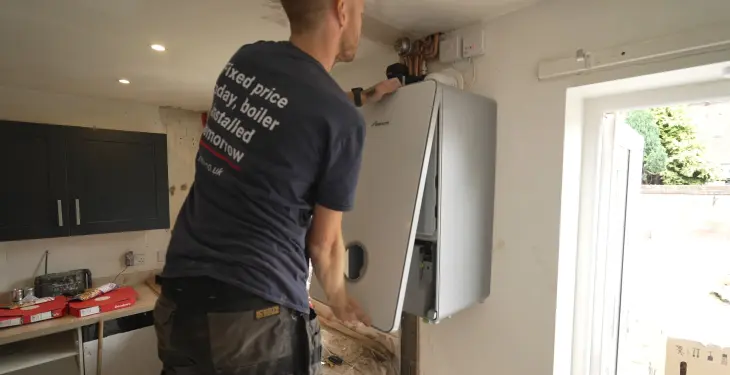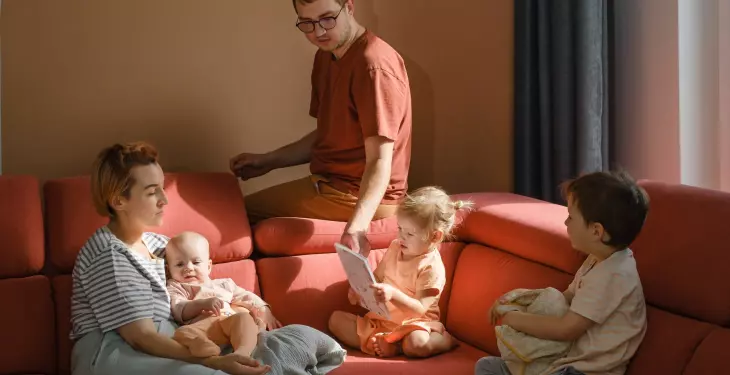

Written by Stephen Day
Gas Safe Engineer
Updated: 30th May, 2025
A radiator not heating up properly can be frustrating. There are several reasons this might happen, and identifying the cause is the first step to fixing it.
Get a new boiler quote, save up to £550 per year (0% APR available).
Dealing with a radiator that doesn't heat up like the others can be a common headache for many homeowners. The most likely reasons for a single radiator not working are a stuck valve or trapped air inside the system.
These issues disrupt the flow of hot water, leaving the radiator cold while others in the house work just fine. It's crucial to address these problems to ensure even heating throughout the home.
Simple steps can address most radiator issues and don't always require professional help.
Bleeding the radiator to release trapped air is one effective solution. Meanwhile, checking and freeing a stuck thermostatic radiator valve (TRV) can also get things working again.
For those unsure of tackling these fixes on their own, there are guides and expert advice available to walk through the repair process.
This article will explore various steps homeowners can take to troubleshoot and fix radiator problems, thus ensuring a cosy and comfortable environment.
Get a quote in 60 seconds, fitted as fast as next day!
0% APR finance available.
A radiator not heating up properly can be frustrating. There are several reasons this might happen, and identifying the cause is the first step to fixing it.
Valve issues often cause cold radiators. Thermostatic Radiator Valves (TRVs) control the temperature for each radiator. If stuck or broken, the radiator might stay cold even with the heating on.
Another common issue is trapped air inside the radiator. Trapped air prevents water from circulating correctly, which can lead to cold spots, often at the top of the radiator. Bleeding the radiator helps release the trapped air, allowing heat to distribute evenly.
Blockages in the system may also be responsible. Sludge build-up in the pipes can block water flow and cause a cold radiator. Professionals might need to perform a power flush to remove these blockages.
Imbalance in the heating system can lead to uneven heat distribution. This means water may not reach the radiator in question effectively, leaving it cold. Balancing the system ensures that water is distributed evenly to all radiators.
Lastly, a faulty boiler or thermostat problem could affect multiple radiators' functionality, including this one. Ensuring the boiler is working correctly and checking for thermostat settings can pinpoint broader system issues.
Addressing these factors will help get the radiator back to working as expected.
When a single radiator is not heating, there are straightforward steps you can take. Start by checking the thermostatic radiator valve (TRV). Sometimes, it gets stuck. Gently tapping it might free it.
If the TRV is fine, see if there is air trapped in the radiator. This can prevent warm water from circulating properly. Bleeding the radiator is a simple job that can fix this issue.
Turn off the heating and wait for radiators to cool.
Place a towel underneath the valve to catch any water.
Use a radiator key to turn the bleed screw anti-clockwise. You should hear a hissing sound as trapped air escapes.
Once water starts trickling out, close the valve firmly.
Next, check the lockshield valve. It might be too closed, restricting water flow. Adjusting it slightly open could resolve the cold radiator problem.
For radiators that are still cold at the bottom, consider the possibility of a blockage. Sludge build-up can occur over time, preventing warmth distribution. In this case, a radiator flush might be necessary. It is best to consult a professional if you suspect debris.
Addressing these common issues will often restore warmth to the radiator. These fixes do not usually require specialist tools, making them accessible for most homeowners.
When a thermostatic radiator valve (TRV) pin is stuck, it can prevent the radiator from heating up. This is a common issue, often due to dirt or a pin jammed in the closed position.
Steps to Free the Valve Pin:
Turn Off the Heating: Ensure the heating is off, and the radiator is cool.
Remove the TRV Head: Unscrew the thermostatic head to expose the pin.
Check the Pin Movement: Gently press down on the pin and release. It should spring back. If it doesn't move, it’s stuck.
Loosen the Pin: Use a pair of pliers to carefully move the pin up and down. Do not pull it out completely.
Clean the Pin Area: Wipe away any visible dirt or debris that might be causing the blockage.
If Stuck Due to Debris:
Vinegar Solution: For buildup like limescale, apply a vinegar-soaked cloth to the pin area. This can help dissolve residues.
Prevention Tips:
Regular Maintenance: Check valves regularly and clean to prevent buildup.
Use Clean Water: Ensure your heating system uses clean water to reduce impurities.
These easy steps can typically solve the problem of a stuck TRV. If issues persist, it might be a sign of a deeper problem requiring professional help.
Bleeding your radiator is a simple yet essential task to maintain efficient heating. Over time, trapped air within the system can lead to uneven heating, causing some areas to stay cold. Bleeding removes this air, allowing hot water to circulate properly.
Tools Needed:
You’ll need a radiator key and a cloth or small container to catch any water.
Steps to Bleed a Radiator:
Turn Off the HeatingEnsure the heating system is off and the radiator is cool. This prevents hot water from spilling out.
Locate the Bleed ValveAt the top or side of most radiators is a small valve. This is where the radiator key fits.
Open the Valve CarefullyUse the radiator key to slowly turn the valve counterclockwise. You should hear a hissing sound as air escapes.
Close the Valve QuicklyOnce water begins to flow, quickly close the valve by turning it clockwise. This seals the system and prevents air from entering again.
Repeat Process:It's often necessary to bleed all radiators in the house, starting from the lowest one and working upwards. This ensures each unit functions efficiently.
Regularly check radiators for airlocks or trapped air to keep your heating system in top condition. This simple maintenance can vastly improve the heat distribution in your home, making it a more comfortable and energy-efficient place.
Balancing a radiator is crucial for even heat distribution throughout a home. If one radiator is not working well, it could be due to an imbalance in the heating system. Radiators that are not balanced can result in uneven temperatures, with some rooms feeling too cold while others are too hot.
To balance radiators, the system involves adjusting the radiator valves, especially the lockshield valve. This valve controls the flow of hot water into each radiator. Ensuring the lockshield valve is set correctly is essential for balancing. Larger rooms or those farther from the boiler might need more hot water flow than smaller, closer ones.
For homes with a combi boiler, proper radiator balancing ensures efficient energy use. Combi boilers heat water directly from the mains, making it even more important for the hot water flow to be managed correctly across radiators.
Balancing involves a series of steps:
Turn off the heating and let the radiators cool.
Adjust the lockshield valves systematically, opening or closing them to equalise the flow.
While balancing might sound complex, it's a straightforward process that can greatly improve comfort and efficiency in a home. Regularly checking and adjusting the radiators in a central heating system can prevent future issues and ensure each room gets the warmth it needs.
Hiring a heating engineer is often necessary when dealing with a non-functional radiator. The cost can vary based on several factors, including location and time of service.
In the UK, the average hourly rate for a plumber or heating engineer is about £60. If it's an emergency, the rate can increase, sometimes reaching £100+ per call-out.
Factors Influencing Cost:
Location: Rates can be higher in large cities compared to rural areas.
Timing: Off-peak times might be cheaper than emergencies or weekend calls.
Complexity: Simple repairs cost less than those requiring more labour.
Sometimes, fixing a radiator involves replacing parts. Thermostatic Radiator Valves (TRVs) or other components might need replacement, adding to the cost.
Basic parts can range from £5 to £50 each. More advanced parts can be pricier. Labour might add extra charges depending on the time it takes to complete the repair.
Hiring a professional ensures the work is done safely and efficiently. While it adds a cost, it often saves future expenses by preventing further damage.
Get a quote in 60 seconds, fitted as fast as next day!
0% APR finance available.
Last updated: 30th May, 2025

Written by Stephen Day
Gas Safe Engineer at iHeat
Stephen Day is a Gas Safe registered and FGAS certified engineer with over 20 years of hands-on experience in the heating, cooling, and renewable energy industry, specialising in boiler installations, air conditioning, and heat pump systems.
LinkedInArticles by Stephen Day are reviewed by iHeat’s technical team to ensure accuracy and reliability.

22nd December, 2025
Based on data from over 7000 boiler installations completed by iHeat in the past 12 months...
 Read Article
Read Article

22nd December, 2025
Here’s a quick roundup of the best combi boilers for 2026.
 Read Article
Read Article

22nd December, 2025
When your old boiler breaks down and it comes time to replace it with a new one, it might...
 Read Article
Read Article
No obligation. Takes less than 60 seconds.